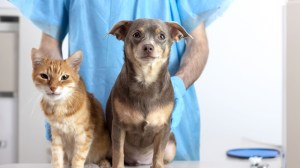DATOS SOBRE LAS CONSECUENCIAS DEL AUMENTO GENERALIZADO DE TEMPERATURAS
Cuál es el riesgo

A medida que las temperaturas aumentan durante todas y cada una de las estaciones, las mascotas corren un mayor riesgo de contraer parásitos y las enfermedades que esos parásitos pueden transmitir durante todo el año.
Hemos reunido a los principales expertos para preguntarles cómo puede afectar esto a nuestras mascotas y al resto de nuestra familia.
En Europa, hay al menos
5
ESPECIES DE MOSQUITOS INVASORAS
algunas pueden transmitirle el gusano del corazón a tu mascota. Además están colonizando nuevas áreas donde nunca antes se habían encontrado.1
En España, hasta el
71,4% DE LOS GATOS
han sido infectados por Bartonella henselae, una bacteria que transmiten las pulgas y que causa la enfermedad del arañazo de gato en personas.2
SE HAN ENCONTRADO GARRAPATAS EN ALTITUDES DE HASTA
2.000 M
COLONIZANDO ASÍ NUEVAS ZONAS3
En el sur de Europa, se estima que
2,5 MILLONES
DE PERROS SON POSITIVOS A LEISHMANIOSIS
un parásito altamente peligroso transmitido por los flebotomos, insectos parecidos a un mosquito.4
Desde 1983
LAS GARRAPATAS SE HAN IDO EXPANDIENDO AL NORTE HASTA
400 KM
sobrepasando Noruega, su anterior límite.5
Solo en Europa, las garrapatas transmiten unas
35
ENFERMEDADES
tanto a personas como a mascotas, algunas de las cuales son potencialmente mortales. Las garrapatas también transmiten al menos una docena de bacterias y parásitos peligrosos.6
ENCUENTRA TODO LO QUE NECESITAS PARA MANTENER A TU MASCOTA PROTEGIDA
Conocer los riesgos es clave para proteger a tu mascota frente a determinadas enfermedades. Hemos recopilado artículos, videos y guías que te ayudarán a mantenerte informado y tomar las medidas oportunas para proteger a tu mascota de las consecuencias producidas por el aumento generalizado de temperaturas.

¿QUÉ DICEN LOS EXPERTOS?
“EL CAMBIO CLIMÁTICO ESTÁ DANDO LUGAR A LA DISPERSIÓN Y AL AUMENTO DE LA DENSIDAD DE LAS GARRAPATAS EN CUALQUIER TERRITORIO EUROPEO, PERO FUNDAMENTALMENTE ESTÁ DANDO LUGAR A UNA ELEVADA IMPREDECIBILIDAD DE LA ACTIVIDAD DE LAS GARRAPATAS. ESO QUIERE DECIR QUE ES PRECISO MANTENER LA PROTECCIÓN EN NUESTRAS MASCOTAS DURANTE TODO EL AÑO.»

PROF. AGUSTÍN ESTRADA
ESPAÑA
“Los mosquitos y los flebotomos son animales de sangre fría y su metabolismo depende directamente de la temperatura ambiente. Si esta se incrementa, empezarán su actividad de forma más temprana, ampliarán su ciclo de actividad, aumentará el número de generaciones al año e incluso en número de picaduras y, por tanto, la capacidad de transmitir enfermedades.”

DR. JAVIER LUCIENTES
ESPAÑA
“La estacionalidad en la prevención frente a los parásitos se ha convertido ya en un mito que debemos erradicar.»

PD DR GERHARD DOBLES
ALEMANIA
“ANTERIORMENTE LAS PULGAS DISMINUÍAN SU ACTIVIDAD DURANTE EL INVIERNO; ACTUALMENTE, LOS INVIERNOS MÁS CÁLIDOS Y LAS CALEFACCIONES EN LOS HOGARES PRODUCEN UN AMBIENTE FAVORABLE QUE LES PERMITE PERMANECER ACTIVAS DURANTE TODO EL AÑO.»

PROF. RICHARD WALL
UK
1 – Medlock, J. M., Hansford, K. M., Schaffner, F., Versteirt, V., Hendrickx, G., Zeller, H., & Van Bortel, W. (2012). A review of the invasive mosquitoes in Europe: ecology, public health risks, and control options. Vector borne and zoonotic diseases (Larchmont, N.Y.), 12(6), 435–447.
https://doi.org/10.1089/vbz.2011.0814
2 – Álvarez-Fernández, A., Breitschwerdt, E. B., & Solano-Gallego, L. (2018). Bartonella infections in cats and dogs including zoonotic aspects. Parasites & Vectors, 11(1), 1-21.
3 – Materna, J., Daniel, M., & Danielová, V. (2005). Altitudinal distribution limit of the tick Ixodes ricinus shifted considerably towards higher altitudes in central Europe: results of three years monitoring in the Krkonose Mts.(Czech Republic). Central European journal of public health, 13(1), 24-28.
Semenza, J. C., & Suk, J. E. (2018). Vector-borne diseases and climate change: a European perspective. FEMS microbiology letters, 365(2), fnx244. https://doi.org/10.1093/femsle/fnx244
4 – Le Rutte, E. A., van der Wilt, L. S., Bulstra, C. A., Nieboer, D., Kontoroupis, P., de Vlas, S. J., & Richardus, J. H. (2021). Incidence and geographical distribution of canine leishmaniosis in 2016—2017 in Spain and France. Veterinary Parasitology: Regional Studies and Reports, 25, 100613.
5 – Jore, S., Viljugrein, H., Hofshagen, M., Brun-Hansen, H., Kristoffersen, A. B., Nygård, K., … & Ytrehus, B. (2011). Multi-source analysis reveals latitudinal and altitudinal shifts in range of Ixodes ricinus at its northern distribution limit. Parasites & vectors, 4(1), 1-11. https://parasitesandvectors.biomedcentral.com/articles/10.1186/1756-3305-4-84
6 – Süss, J., & Schrader, C. (2004). Durch Zecken übertragene humanpathogene und bisher als apathogen geltende Mikroorganismen in Europa. Teil I: Zecken und Viren [Tick-borne human pathogenic microorganisms found in Europe and those considered nonpathogenic. Part I: Ticks and Viruses]. Bundesgesundheitsblatt, Gesundheitsforschung, Gesundheitsschutz, 47(4), 392–404. https://doi.org/10.1007/s00103-003-0766-3
Tu veterinario es esencial en el cuidado y salud de tu mascota.
ENCUENTRA UN VETERINARIO



 Go To United States
Go To United States  Austria
Austria  Belgium
Belgium  Czech Republic
Czech Republic  Denmark
Denmark  Finland
Finland  France
France  Germany
Germany  Greece
Greece  Hungary
Hungary  Ireland
Ireland  Israel
Israel  Italy
Italy  Netherlands
Netherlands  Norway
Norway  Poland
Poland  Portugal
Portugal  Romania
Romania  Spain
Spain  Sweden
Sweden  Turkey
Turkey  United Kingdom
United Kingdom